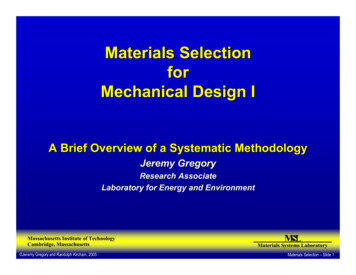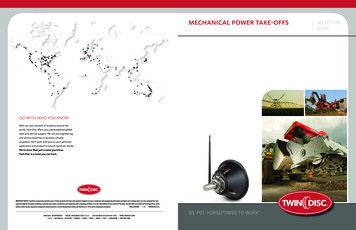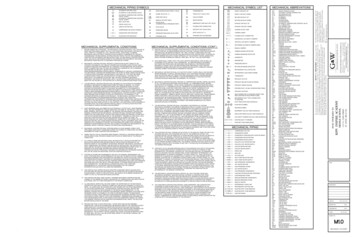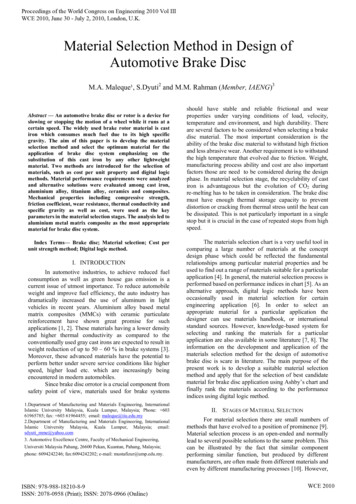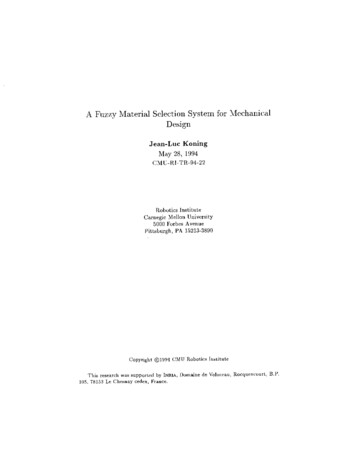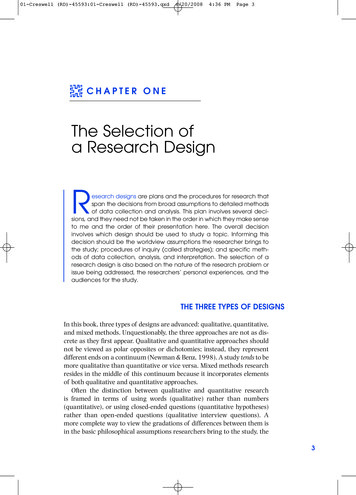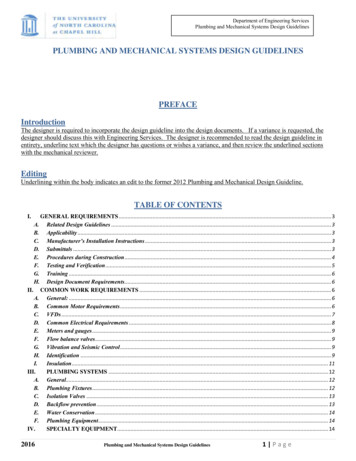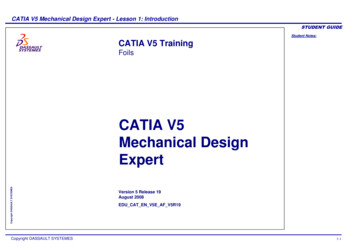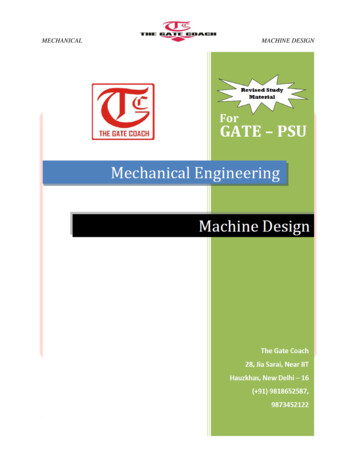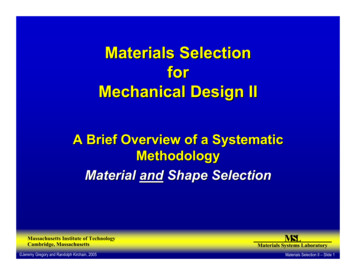
Transcription
Materials SelectionforMechanical Design IIA Brief Overview of a SystematicMethodologyMaterial and Shape SelectionMassachusetts Institute of TechnologyCambridge, Massachusetts Jeremy Gregory and Randolph Kirchain, 2005Materials Systems LaboratoryMaterials Selection II – Slide 1
Method for Early Technology Screening Design performance isdetermined by thecombination of: ShapeMaterialsProcessUnderlying principles ofselection are unchanged MaterialsProcessShapeBUT, do not underestimateimpact of shape or thelimitation of processMassachusetts Institute of TechnologyCambridge, Massachusetts Jeremy Gregory and Randolph Kirchain, 2005Materials Systems LaboratoryMaterials Selection – Slide 2
Material and Shape Selection Performance isn't just about materials - shape canalso play an important roleShape can be optimized to maximize performancefor a given loading conditionSimple cross-sectional geometries are not alwaysoptimal Shape is limited by material Efficient Shapes like I-beams, tubes can be betterWood can be formed only so thinGoal is to optimize both shape and material for agiven loading conditionMassachusetts Institute of TechnologyCambridge, Massachusetts Jeremy Gregory and Randolph Kirchain, 2005Materials Systems LaboratoryMaterials Selection – Slide 3
Loading Conditions and Shape Different loadingconditions areenhanced bymaximizing differentgeometric propertiesArea for tensionSecond moment forcompression andbendingPolar moment fortorsionσ FAFFδArea ATension : TieFσ MyIδArea A moment Iτ TrJrθArea A polar moment JFcrit nπ2 EIl2Bending : BeamTTTwisting : ShaftFArea A moment IFCompression : ColumnFigure by MIT OCW.Massachusetts Institute of TechnologyCambridge, Massachusetts Jeremy Gregory and Randolph Kirchain, 2005Materials Systems LaboratoryMaterials Selection – Slide 4
Shapes and arMomentbh3 b 10.58 3 h Massachusetts Institute of TechnologyCambridge, Massachusetts Jeremy Gregory and Randolph Kirchain, 20054π22r4rtt4π ( ro2 ri 2 )πr(4π4or(24obb2t ( h b )2t ( h b )4)1 3 b 1 3 b h t 1 3 h t 1 3 h 6 h 6 4)2tb 2 h 2 t 1 (h b) h ri rih4h 2 3 bt 1 4 b 3 Materials Systems LaboratoryMaterials Selection – Slide 5
Shape Factor Definition Shape factor measures efficiency for amode of loading given an equivalent crosssection “Efficiency”: For a given loading condition,section uses as little material as possibleDefined as 1 for a solid cross-section Higher number is better, more efficientSeφ SoMassachusetts Institute of TechnologyCambridge, Massachusetts Jeremy Gregory and Randolph Kirchain, 2005For elastic cases:φ shape factorS stiffness of cross-section under questionSo stiffness of reference solid cross-sectionMaterials Systems LaboratoryMaterials Selection – Slide 6
Shape Factor for Elastic BendingSEIIφ So EI o I oeBReference solid cross-section42boAoIo 12 12boboI 12 Iφ 2IoAeBMassachusetts Institute of TechnologyCambridge, Massachusetts Jeremy Gregory and Randolph Kirchain, 2005Compare sectionsof same area Ao ANotice that shape factor isdimensionlessMaterials Systems LaboratoryMaterials Selection – Slide 7
I-Beam Elastic Bending ShapeFactortbot 0.125h 3b 1hboAo bo2bo 1Ao 1For these dimensions, the shapeincreased stiffness over 13 times whileusing the same amount of material!Is this design possible in all materials?Massachusetts Institute of TechnologyCambridge, Massachusetts Jeremy Gregory and Randolph Kirchain, 2005bA 2t ( h b )A 1 Ao1 3 b I h t 1 3 1.1256 h 12 IeφB 2 13.5AMaterials Systems LaboratoryMaterials Selection – Slide 8
Materials Limit Best Achievable ShapeFactor Shape efficiency dependent on materialConstraints: manufacturing, material properties, local buckling For example, can’t have thin sections of woodValues in table determined empiricallyNote: previous design not possible in polymers, wood (φeB) 13.5BendingMaterialStructural SteelsAluminum Alloys(φ )eB maxTorsion(φ )eT max65442531GFRP and CFRP3926PolymersWoods12681Massachusetts Institute of TechnologyCambridge, Massachusetts Jeremy Gregory and Randolph Kirchain, 2005Materials Systems LaboratoryMaterials Selection – Slide 9
Shape Factors and Material IndicesExample: Bending BeamMass: m AL ρBending Stiffenss: S Shape Factor: φBe F δCEIL3I 12 I 2IoAReplace I in Stiffness using φBe : S C E e 2φ A3 B12 L1/ 2 12 S Eliminate A from mass using stiffness: m C (φBe E ) ρL5 / 2 φeE B(1/ 2Material Index: M Massachusetts Institute of TechnologyCambridge, Massachusetts Jeremy Gregory and Randolph Kirchain, 2005ρPreviously: M 1/ 2 )E1/ 2ρMaterials Systems LaboratoryMaterials Selection – Slide 10
Shape Factors and Material Indices: BeamsObjective: Minimize MassPerformance Metric: �LoadingStrength Limitedσf/ρMaximize!Massachusetts Institute of TechnologyCambridge, Massachusetts Jeremy Gregory and Randolph Kirchain, 2005Materials Systems LaboratoryMaterials Selection – Slide 11
Shape Factors Affect Material Choice Shape factors candramatically improveperformance for agiven loadingconditionThe optimalcombination of shapeand material leads tothe best designMassachusetts Institute of TechnologyCambridge, Massachusetts Jeremy Gregory and Randolph Kirchain, 2005CeramicsCompositesM with φ 10WoodsFoamsM with φ 1MetalsPolymersElastomersMaterials Systems LaboratoryMaterials Selection – Slide 12
Example Problem: Bicycle ForksPhotos of bicycle forks removed for copyright reasons. Bicycle forks need to be lightweightPrimary constraint can be stiffness orstrengthToughness and cost can be otherconstraintsMassachusetts Institute of TechnologyCambridge, Massachusetts Jeremy Gregory and Randolph Kirchain, 2005Materials Systems LaboratoryMaterials Selection – Slide 13
Bicycle Forks: Problem Definition Function: Objective: Minimize massLConstraints: Forks - supportbending loadsLength specifiedMust not fail(strength constraint)Free variables: MaterialArea: Tube radius ORthickness OR shapeMassachusetts Institute of TechnologyCambridge, Massachusetts Jeremy Gregory and Randolph Kirchain, 2005FObjective: m AL ρMym FLymConstraint: σ σ fIIFree Variables:Solid Tube: A π r2I π r44Hollow Tube: A 2π rt I π r 3t4 πZShape: φ 3/ 2AfBIZ ymMaterials Systems LaboratoryMaterials Selection – Slide 14
Material Indices: Shape specifiedFree variable definition importantSolid SectionHollow SectionHollow SectionFree Variable: AreaFree Variable: RadiusFree Variable: ThicknessMym σ fI4 FLσf 3πrSolve for r:σ Mym σ fIFLσf 2πr tSolve for r:Mym σ fIFLσf 2πr tSolve for t :σ 1/ 3 4 FL r πσ f Substitute into m: ρ 2/3m π 1/ 3 ( 4 F ) L2 / 3 2 / 3 σ f σ 2f / 3 Maximize: M ρ Massachusetts Institute of TechnologyCambridge, Massachusetts Jeremy Gregory and Randolph Kirchain, 2005σ 1/ 2FLπ r 2σ f FL r π tσ f Substitute into m:t ρ 1/ 2m ( 4π F ) L3t 1/ 2 σ f σ 1/f 2 Maximize: M ρ L2m 2Fr( )1/ 2Substitute into m: ρ σ f σ f Maximize: M ρ Materials Systems LaboratoryMaterials Selection – Slide 15
Material Index with Shape FreeFLym FL FL 4 πσf f 3/ 2φB AIZSolve for A: FL 4 πA f φB σ f 2/3Massachusetts Institute of TechnologyCambridge, Massachusetts Jeremy Gregory and Randolph Kirchain, 2005Substitute into m: ρ5/ 3 m 4 πFL φ f σ 2/3 B f φ f σ 2/3 Bf Maximize: M ρ ()2/3(())Materials Systems LaboratoryMaterials Selection – Slide 16
Material indices with shape factors changematerial selection***σf (MPa)ρ (Mg/m3)φ fBσf2/3/ρ(φfBσf)2/3/ρSpruce (Norwegian)800.5113636Bamboo1200.72.23559Steel (Reynolds 531)8807.827.51245Alu (6061-T6)2502.75.91548Titanium 6-49554.425.92272Magnesium AZ l Index w/out shape factorMassachusetts Institute of TechnologyCambridge, Massachusetts Jeremy Gregory and Randolph Kirchain, 2005**Material Index with shape factorMaterials Systems LaboratoryMaterials Selection – Slide 17
Strength ConstraintMedium carbon steelAge-hardening w rought Al-alloysTitanium alloys1e9CFRP, epoxy m atrix (isotropic)Tensile Strength (Pa)Wrought m agnesium alloysHardw ood: oak, along grain1e8Softw ood: pine, along grainBam boo1e71e6100100010000Density (kg/m 3)Chart from the CES EduPack 2005, Granta Design Limited, Cambridge, UK. (c)Granta Design. Courtesy of Granta Design Limited. Used with permission.Massachusetts Institute of TechnologyCambridge, Massachusetts Jeremy Gregory and Randolph Kirchain, 2005Materials Systems LaboratoryMaterials Selection – Slide 18
Stiffness ConstraintMedium carbon steelAge-hardening w rought Al-alloysCFRP, epoxy m atrix (isotropic)1e11Wrought m agnesium alloysHardw ood: oak, along grainBam booYoung's Modulus (Pa)1e10Softw ood: pine, along grain1e91e81e71e6100100010000Density (kg/m 3)Chart from the CES EduPack 2005, Granta Design Limited, Cambridge, UK. (c)Granta Design. Courtesy of Granta Design Limited. Used with permission.Massachusetts Institute of TechnologyCambridge, Massachusetts Jeremy Gregory and Randolph Kirchain, 2005Materials Systems LaboratoryMaterials Selection – Slide 19
Example of Material Selection includingShape: Floor JoistsWood beamSteel I-beamMaterial for floor joists***Density (g/cm3) 0.58 7.9Modulus (GPa) 10 210Material Cost ( /kg) 0.90 0.65φeB2.0-2.215-25E1/2/Cmρ 6.1 2.8(φeBE)1/2/Cmρ 8.8 12.6*Material Index w/out shape factorMassachusetts Institute of TechnologyCambridge, Massachusetts Jeremy Gregory and Randolph Kirchain, 2005**Material Index with shape factorMaterials Systems LaboratoryMaterials Selection – Slide 20
Jeremy Gregory and Randolph Kirchain, 2005 Materials Selection – Slide 17 Material indices with shape factors change material selection CFRP 375 1.5 4.25 35 91 Magnesium AZ 61 165 1.8 4.25 17 44 Titanium 6-4 955 4.42 5.9 22 72 Alu (6061-T6) 250 2.7 5.9 15 48 Steel (Reynolds 531) 880 7.82 7.5 12 45 Bamboo 120 0.7 2.2 35 59

